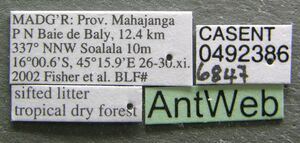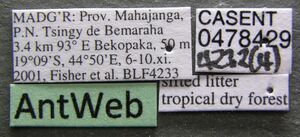Vitsika crebra
| Vitsika crebra | |
|---|---|

| |
| Scientific classification | |
| Kingdom: | Animalia |
| Phylum: | Arthropoda |
| Class: | Insecta |
| Order: | Hymenoptera |
| Family: | Formicidae |
| Subfamily: | Myrmicinae |
| Tribe: | Crematogastrini |
| Genus: | Vitsika |
| Species: | V. crebra |
| Binomial name | |
| Vitsika crebra Bolton & Fisher, 2014 | |
All examples of this species originate in tropical dry forest. They have been found as ground foragers, in pitfall traps, in litter samples, in rotten logs, in dead twigs above the ground, and by beating low vegetation.
Identification
Bolton and Fisher (2014) - One of the most easily recognised species of Vitsika. The combination of yellow colour, short propodeal spines, and very broad postpetiole that is uniformly densely sculptured dorsally, is not repeated anywhere else in the genus.
Keys including this Species
Distribution
Endemic to Madagascar.
Latitudinal Distribution Pattern
Latitudinal Range: -18.71666667° to -18.71666667°.
| North Temperate |
North Subtropical |
Tropical | South Subtropical |
South Temperate |
- Source: AntMaps
Distribution based on Regional Taxon Lists
Malagasy Region: Madagascar (type locality).
Distribution based on AntMaps
Distribution based on AntWeb specimens
Check data from AntWeb
Countries Occupied
| Number of countries occupied by this species based on AntWiki Regional Taxon Lists. In general, fewer countries occupied indicates a narrower range, while more countries indicates a more widespread species. |

|
Estimated Abundance
| Relative abundance based on number of AntMaps records per species (this species within the purple bar). Fewer records (to the left) indicates a less abundant/encountered species while more records (to the right) indicates more abundant/encountered species. |

|
Biology
Castes
Worker
Images from AntWeb
   
| |
| Holotype of Vitsika crebra. Worker. Specimen code casent0473810. Photographer Michele Esposito, uploaded by California Academy of Sciences. | Owned by CAS, San Francisco, CA, USA. |
   
| |
| Worker. Specimen code casent0486335. Photographer April Nobile, uploaded by California Academy of Sciences. | Owned by CAS, San Francisco, CA, USA. |
Queen
Images from AntWeb
   
| |
| Queen (alate/dealate). Specimen code casent0492386. Photographer Erin Prado, uploaded by California Academy of Sciences. | Owned by CAS, San Francisco, CA, USA. |
   
| |
| Queen (alate/dealate). Specimen code casent0478429. Photographer Estella Ortega, uploaded by California Academy of Sciences. | Owned by CAS, San Francisco, CA, USA. |
    
| |
| Queen (alate/dealate). Specimen code casent0430544. Photographer Michele Esposito, uploaded by California Academy of Sciences. | Owned by CAS, San Francisco, CA, USA. |
Male
Images from AntWeb
     
| |
| Male (alate). Specimen code casent0050262. Photographer April Nobile, uploaded by California Academy of Sciences. | Owned by CAS, San Francisco, CA, USA. |

| |
| Queen (alate/dealate). Specimen code casent0000692. Photographer Erin Prado, uploaded by California Academy of Sciences. | Owned by CAS, San Francisco, CA, USA. |
     
| |
| Male (alate). Specimen code casent0424700. Photographer Erin Prado, uploaded by California Academy of Sciences. | Owned by CAS, San Francisco, CA, USA. |
Nomenclature
The following information is derived from Barry Bolton's Online Catalogue of the Ants of the World.
- crebra. Vitsika crebra Bolton & Fisher, 2014: 76, figs. 90-92, Map 152 (w.q.m.) MADAGASCAR.
Unless otherwise noted the text for the remainder of this section is reported from the publication that includes the original description.
Description
Worker
(holotype in parentheses). TL 3.0–3.7 (3.5), HL 0.69–0.84 (0.80), HW 0.55–0.69 (0.65), CI 79–84 (81), SL 0.49–0.61 (0.60), SI 86–91 (91), PW 0.42–0.54 (0.51), WL 0.84–1.07 (1.02) (25 measured).
Eye with 7–8 rows of ommatidia, and with 9–10 ommatidia in the longest row; EL 0.18–0.23 (EL/HW 0.30–0.34). Eye in profile not tear-drop shaped, not coming to a point anteriorly; the anterior and posterior curvatures of the eye almost equally convex. MfL 0.60–0.76 (MfL/HW 1.03–1.15). Oblique costulae on mesopleuron sparse and weak. In profile, the dorsal outline of the propodeum forms an even slope from just behind the metanotal groove to the base of the spine. Propodeal declivity lacks transverse costulae. Diameter of annulus of propodeal spiracle is slightly less than, to about equal to, the thickness of the short propodeal spine at its midlength. Petiole node in posterior view low and broad, its posterior surface usually with some reticulate-punctulate sculpture, at least on the lower half. Height of petiole node in posterior view (from midpoint of the dorsal margin of the foramen to the apex) 0.75–0.90 × its maximum width. In dorsal view postpetiole 1.33–1.42 × broader than long; maximum width of postpetiole 1.95–2.25 × the length of a propodeal spine; maximum width of postpetiole 1.25–1.50 × the distance between the apices of the propodeal spines. Disc of postpetiole entirely sculptured with reticulate-punctulation, and also usually with some weak rugulae present. Full adult colour uniform yellow.
Queen
(gyne). Only alates known; may be polygynous as more than one queen appears in some series. HL 0.80–0.86, HW 0.68–0.72, CI 84–86, SL 0.56–0.60, SI 81–85, PW 0.58–0.62, WL 1.14–1.18, MfL 0.72–0.76 (4 measured). As in the worker the postpetiole is very broad and entirely sculptured dorsally, and the propodeal spines are short.
Male
HL 0.65, HW 0.54, CI 83, SL 0.27, SI 50, mesoscutum width at maximum 0.52, WL 1.00, EL 0.27, MfL 0.64 (1 measured). Propodeal dorsum finely punctulate and with scattered fine, longitudinal rugulae. Propodeal dorsum without a median longitudinal carina, but upper half of declivity with a median carina present; a fine rugula on each side separates the declivity from the side of the propodeum. Propodeum in profile unarmed, the rounded angle between dorsum and declivity surmounted by a an extremely low, rounded cuticular crest. Postpetiole in dorsal view broader than long, the surface finely punctulate-shagreenate. Postpetiole in profile longer than high. Colour yellow.
Type Material
Holotype worker, Madagascar: Prov. Mahajanga, P.N. Tsingy de Bemaraha, 10.6 km. 123° ESE Antsalova, 150 m., 18°43’S, 44°43’E, 16–20.xi.2001, sifted litter, tropical dry forest, BLF 4432(1), CASENT0473810 (Fisher et al.) (California Academy of Sciences). Paratypes. 7 workers and 2 dealate queens, with same data as holotype and all BLF 4432: workers, (6) CASENT0473811, (10) CASENT0473813, (12) CASENT0473814, (14) CASENT0473815, (18) CASENT0473818, (19) CASENT0473819, (40) CASENT0473809; queens, (15) CASENT0473816, (27) CASENT0473822 (CASC). [The nine paratype specimens were selected from leaf litter series BLF 4432, which contains another 18 workers and 2 dealate queens, all in CASC.]
References
- Bolton, B. & Fisher, B.L. 2014. The Madagascan endemic myrmicine ants related to Eutetramorium (Hymenoptera: Formicidae): taxonomy of the genera Eutetramorium Emery, Malagidris nom. n., Myrmisaraka gen. n., Royidris gen. n., and Vitsika gen. n. Zootaxa 3791:1–99. doi:10.11646/zootaxa.3791.1.1
References based on Global Ant Biodiversity Informatics
- Bolton B., and B. L. Fisher. 2014. The Madagascan endemic myrmicine ants related to Eutetramorium (Hymenoptera: Formicidae): taxonomy of the genera Eutetramorium Emery, Malagidris nom. n., Myrmisaraka gen. n., Royidris gen. n., and Vitsika gen. n. Zootaxa 3791(1): 1-99.

